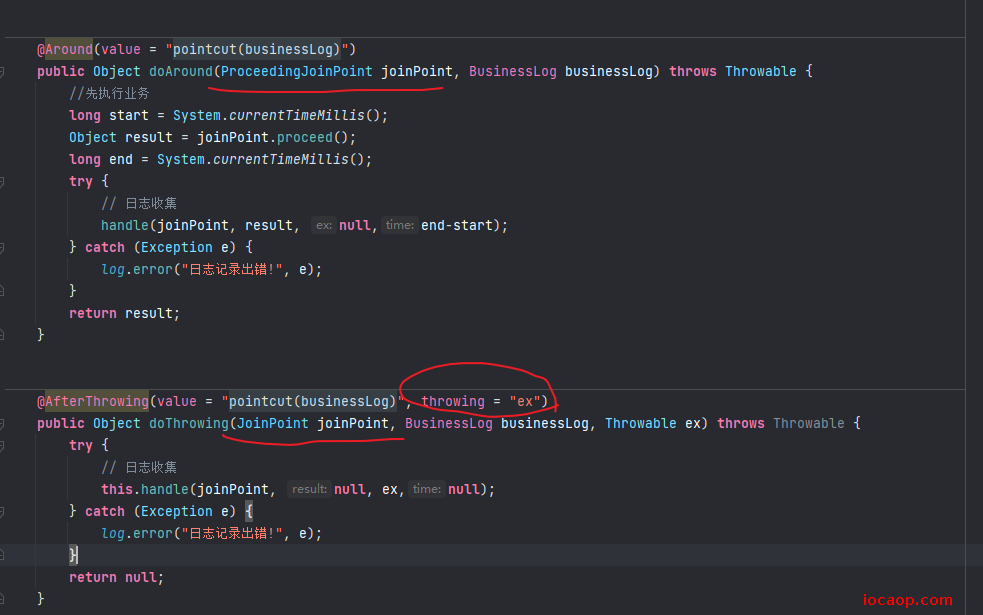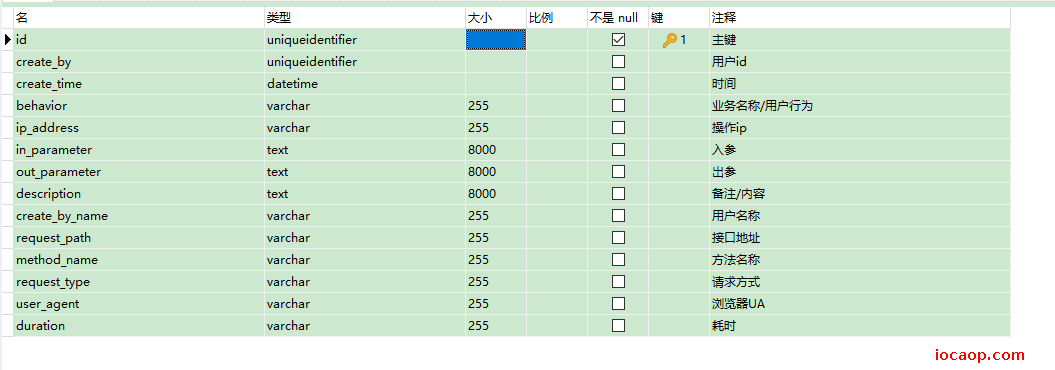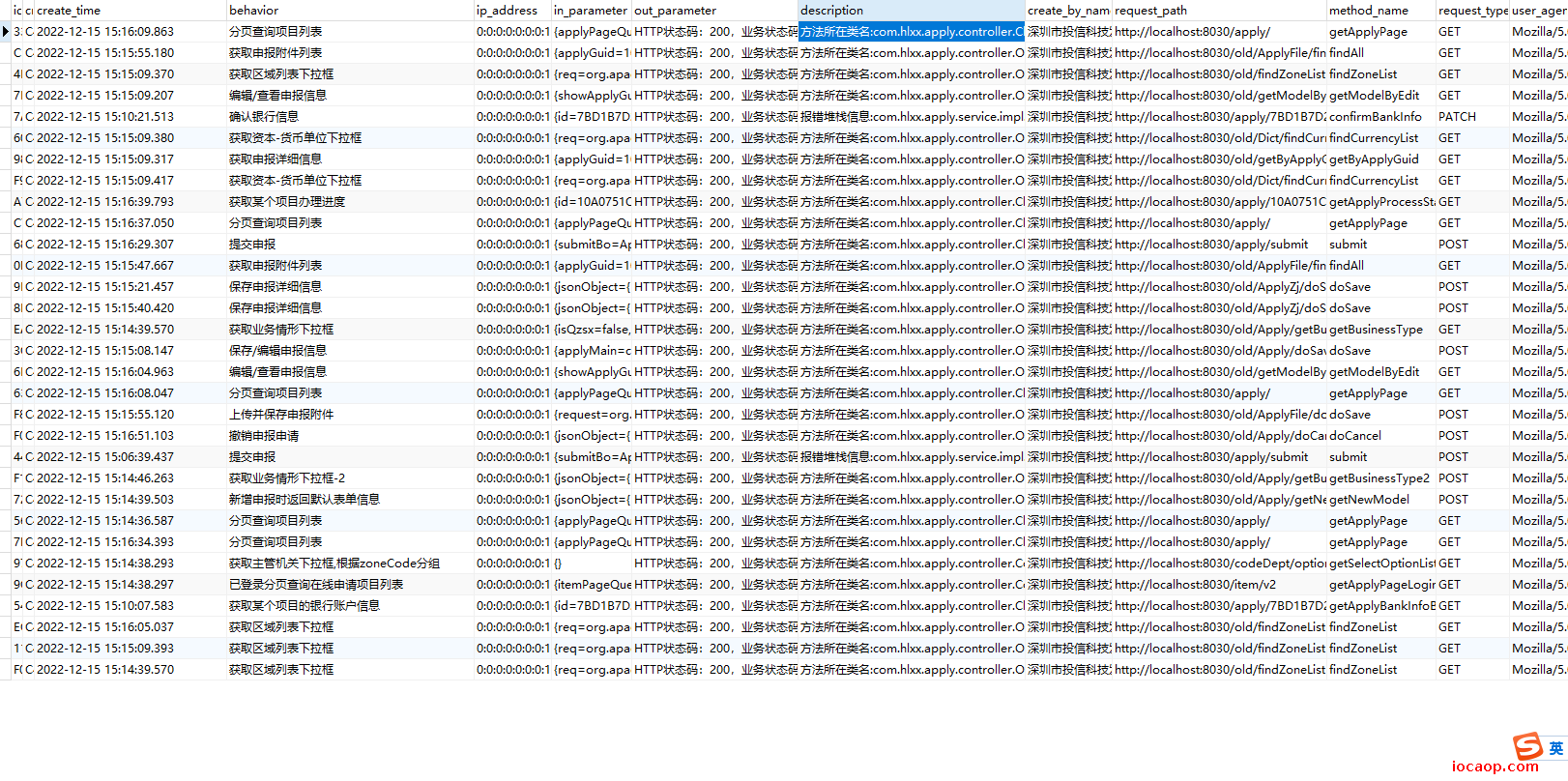aop实现日志收集
2022年12月14日
参考文章:点击跳转
工作中,日志记录到数据库中,所以做了这个切面+注解。
表结构设计:

ddl脚本:
/*
Navicat Premium Data Transfer
Source Server : 测试
Source Server Type : SQL Server
Source Server Version : 15002000
Source Host : 192.168.1.168:1433
Source Catalog : SZES_GXJ
Source Schema : dbo
Target Server Type : SQL Server
Target Server Version : 15002000
File Encoding : 65001
Date: 15/12/2022 11:25:56
*/
-- ----------------------------
-- Table structure for gxj_log
-- ----------------------------
IF EXISTS (SELECT * FROM sys.all_objects WHERE object_id = OBJECT_ID(N'[dbo].[gxj_log]') AND type IN ('U'))
DROP TABLE [dbo].[gxj_log]
GO
CREATE TABLE [dbo].[gxj_log] (
[id] uniqueidentifier NOT NULL,
[create_by] uniqueidentifier NULL,
[create_time] datetime NULL,
[behavior] varchar(255) COLLATE Chinese_PRC_CI_AS NULL,
[ip_address] varchar(255) COLLATE Chinese_PRC_CI_AS NULL,
[in_parameter] varchar(8000) COLLATE Chinese_PRC_CI_AS NULL,
[out_parameter] varchar(8000) COLLATE Chinese_PRC_CI_AS NULL,
[description] varchar(8000) COLLATE Chinese_PRC_CI_AS NULL,
[create_by_name] varchar(255) COLLATE Chinese_PRC_CI_AS NULL,
[request_path] varchar(255) COLLATE Chinese_PRC_CI_AS NULL,
[method_name] varchar(255) COLLATE Chinese_PRC_CI_AS NULL,
[request_type] varchar(255) COLLATE Chinese_PRC_CI_AS NULL,
[user_agent] varchar(255) COLLATE Chinese_PRC_CI_AS NULL,
[duration] varchar(255) COLLATE Chinese_PRC_CI_AS NULL
)
GO
ALTER TABLE [dbo].[gxj_log] SET (LOCK_ESCALATION = TABLE)
GO
EXEC sp_addextendedproperty
'MS_Description', N'主键',
'SCHEMA', N'dbo',
'TABLE', N'gxj_log',
'COLUMN', N'id'
GO
EXEC sp_addextendedproperty
'MS_Description', N'用户id',
'SCHEMA', N'dbo',
'TABLE', N'gxj_log',
'COLUMN', N'create_by'
GO
EXEC sp_addextendedproperty
'MS_Description', N'时间',
'SCHEMA', N'dbo',
'TABLE', N'gxj_log',
'COLUMN', N'create_time'
GO
EXEC sp_addextendedproperty
'MS_Description', N'业务名称/用户行为',
'SCHEMA', N'dbo',
'TABLE', N'gxj_log',
'COLUMN', N'behavior'
GO
EXEC sp_addextendedproperty
'MS_Description', N'操作ip',
'SCHEMA', N'dbo',
'TABLE', N'gxj_log',
'COLUMN', N'ip_address'
GO
EXEC sp_addextendedproperty
'MS_Description', N'入参',
'SCHEMA', N'dbo',
'TABLE', N'gxj_log',
'COLUMN', N'in_parameter'
GO
EXEC sp_addextendedproperty
'MS_Description', N'出参',
'SCHEMA', N'dbo',
'TABLE', N'gxj_log',
'COLUMN', N'out_parameter'
GO
EXEC sp_addextendedproperty
'MS_Description', N'备注/内容',
'SCHEMA', N'dbo',
'TABLE', N'gxj_log',
'COLUMN', N'description'
GO
EXEC sp_addextendedproperty
'MS_Description', N'用户名称',
'SCHEMA', N'dbo',
'TABLE', N'gxj_log',
'COLUMN', N'create_by_name'
GO
EXEC sp_addextendedproperty
'MS_Description', N'接口地址',
'SCHEMA', N'dbo',
'TABLE', N'gxj_log',
'COLUMN', N'request_path'
GO
EXEC sp_addextendedproperty
'MS_Description', N'方法名称',
'SCHEMA', N'dbo',
'TABLE', N'gxj_log',
'COLUMN', N'method_name'
GO
EXEC sp_addextendedproperty
'MS_Description', N'请求方式',
'SCHEMA', N'dbo',
'TABLE', N'gxj_log',
'COLUMN', N'request_type'
GO
EXEC sp_addextendedproperty
'MS_Description', N'浏览器UA',
'SCHEMA', N'dbo',
'TABLE', N'gxj_log',
'COLUMN', N'user_agent'
GO
EXEC sp_addextendedproperty
'MS_Description', N'耗时',
'SCHEMA', N'dbo',
'TABLE', N'gxj_log',
'COLUMN', N'duration'
GO
-- ----------------------------
-- Primary Key structure for table gxj_log
-- ----------------------------
ALTER TABLE [dbo].[gxj_log] ADD CONSTRAINT [PK__gxj_log__3213E83FEE436FC0] PRIMARY KEY CLUSTERED ([id])
WITH (PAD_INDEX = OFF, STATISTICS_NORECOMPUTE = OFF, IGNORE_DUP_KEY = OFF, ALLOW_ROW_LOCKS = ON, ALLOW_PAGE_LOCKS = ON)
ON [PRIMARY]
GO
创建注解:
/**
* 自定义注解记录业务日志
*
* @author laizhuocheng
* @date 2022/12/14
*/
@Target(ElementType.METHOD)
@Retention(RetentionPolicy.RUNTIME)
public @interface BusinessLog {
}
创建切面并加到ioc,因为需要操作数据库:
/**
* 日志切面
*
* @author laizhuocheng
* @date 2022/12/14
*/
@Aspect
@Component
@Slf4j
public class LoggerAspect {
@Autowired
private GxjLogService gxjLogService;
/**
* 切入点 --指定哪些方法需要执行AOP
*
* @param businessLog 业务日志注解
*/
@Pointcut(value = "@annotation(businessLog)")
public void pointcut(BusinessLog businessLog) {
}
}
正常执行,记录日志,使用环绕通知:
@Around(value = "pointcut(businessLog)")
public Object doAround(ProceedingJoinPoint joinPoint, BusinessLog businessLog) throws Throwable {
//先执行业务 简单计时
long start = System.currentTimeMillis();
Object result = joinPoint.proceed();
long end = System.currentTimeMillis();
try {
// 日志收集
handle(joinPoint, result, null,end-start);
} catch (Exception e) {
log.error("日志记录出错!", e);
}
return result;
}
如果接口报错,需要收集错误信息,使用异常通知:
@AfterThrowing(value = "pointcut(businessLog)", throwing = "ex")
public Object doThrowing(JoinPoint joinPoint, BusinessLog businessLog, Throwable ex) throws Throwable {
try {
// 日志收集
this.handle(joinPoint, null, ex,null);
} catch (Exception e) {
log.error("日志记录出错!", e);
}
return null;
}
需要注意的是:

日志收集方法封装:
private void handle(JoinPoint point, Object result, Throwable ex,Long time) throws Exception {
// 获取当前请求
HttpServletRequest request = this.getCurrentRequest();
// 获取当前响应
HttpServletResponse response = this.getCurrentResponse();
// 获取注解所在的方法
Method currentMethod = this.getCurrentMethod(point);
//获取注解方法上对应的swagger注解的参数-操作名称,所以业务日志注解不需要参数
ApiOperation annotation = currentMethod.getAnnotation(ApiOperation.class);
String behavior = annotation.value();
// ip
String ip = IPUtils.getIpAddr(request);
// 获取参数和参数值 封装到map
Map<String, Object> paramMap = this.getParamMap(point);
// 当前用户
ClientCorp user = UserThreadLocalContext.getUser();
// 日志对象
GxjLog gxjLog = new GxjLog().setId(UUID.randomUUID().toString())
.setCreateBy(user.getCorpGUID())
.setCreateTime(DateUtil.toLocalDateTime(new Date()))
.setBehavior(behavior)
.setIpAddress(ip)
.setInParameter(paramMap.toString()).setUserAgent(request.getHeaders("User-Agent").nextElement())
.setCreateByName(user.getCorpName())
.setRequestPath(request.getRequestURL().toString())
.setMethodName(currentMethod.getName())
.setRequestType(request.getMethod())
.setDuration(String.valueOf(time))
.setDescription("方法所在类名:" + currentMethod.getDeclaringClass().getName());
;
if (null != request && null == ex) {
gxjLog.setOutParameter("HTTP状态码:" + response.getStatus() +",业务状态码:200"+ ",响应体:" + new ObjectMapper().writeValueAsString(result));
} else {
if (ex instanceof BusinessException){
BusinessException exception = (BusinessException) ex;
gxjLog.setOutParameter("HTTP状态码:" + response.getStatus()+",业务状态码:"+exception.getCode()+",报错信息:" + ex.getMessage());
}else {
gxjLog.setOutParameter("HTTP状态码:" + response.getStatus()+",报错信息:" + ex.getMessage());
}
StackTraceElement[] stackArray = ex.getStackTrace();
StringBuffer sb = new StringBuffer();
for (int i = 0; i < stackArray.length; i++) {
StackTraceElement element = stackArray[i];
sb.append(element.toString() + "\n");
}
gxjLog.setDescription(sb.toString());
}
gxjLogService.save(gxjLog);
}
日志收集方法涉及到的工具:
获取当前请求和响应,参考文章:点击跳转
/**
* 获取当前请求
*
* @return {@link HttpServletRequest}
*/
private HttpServletRequest getCurrentRequest() {
RequestAttributes requestAttributes = RequestContextHolder.getRequestAttributes();
ServletRequestAttributes servletRequestAttributes = (ServletRequestAttributes) requestAttributes;
HttpServletRequest request = servletRequestAttributes.getRequest();
return request;
}
/**
* 获取当前请求
*
* @return {@link HttpServletRequest}
*/
private HttpServletResponse getCurrentResponse() {
RequestAttributes requestAttributes = RequestContextHolder.getRequestAttributes();
ServletRequestAttributes servletRequestAttributes = (ServletRequestAttributes) requestAttributes;
HttpServletResponse response = servletRequestAttributes.getResponse();
return response;
}
获取当前方法:
/**
* 获取当前方法
*
* @param point 点
* @return {@link Method}
* @throws NoSuchMethodException 没有这个方法,需要抛出的异常
*/
private Method getCurrentMethod(JoinPoint point) throws NoSuchMethodException {
Signature sig = point.getSignature();
MethodSignature msig = (MethodSignature) sig;
Object target = point.getTarget();
Method currentMethod = target.getClass().getMethod(msig.getName(), msig.getParameterTypes());
return currentMethod;
}
获取方法参数和值键值对:
/**
* 获取方法参数和值键值对
*
* @param point 点
* @return {@link HashMap}<{@link String}, {@link Object}>
*/
private Map<String, Object> getParamMap(JoinPoint point) {
Signature sig = point.getSignature();
MethodSignature msig = (MethodSignature) sig;
Object[] args = point.getArgs();
String[] parameterNames = msig.getParameterNames();
HashMap<String, Object> paramMap = new HashMap();
for (int i = 0; i < parameterNames.length; i++) {
paramMap.put(parameterNames[i], args[i]);
}
return paramMap;
}
获取真实ip地址:参考文章:点击跳转
/**
* ip工具类
*
* @author laizhuocheng
* @date 2022/12/15
*/
public class IPUtils {
private static Logger logger = LoggerFactory.getLogger(IPUtils.class);
/**
* 获取IP地址
* 使用Nginx等反向代理软件, 则不能通过request.getRemoteAddr()获取IP地址
* 如果使用了多级反向代理的话,X-Forwarded-For的值并不止一个,而是一串IP地址,X-Forwarded-For中第一个非unknown的有效IP字符串,则为真实IP地址
*/
public static String getIpAddr(HttpServletRequest request) {
String ip = null;
try {
ip = request.getHeader("x-forwarded-for");
if (StringUtils.isEmpty(ip) || "unknown".equalsIgnoreCase(ip)) {
ip = request.getHeader("Proxy-Client-IP");
}
if (StringUtils.isEmpty(ip) || ip.length() == 0 || "unknown".equalsIgnoreCase(ip)) {
ip = request.getHeader("WL-Proxy-Client-IP");
}
if (StringUtils.isEmpty(ip) || "unknown".equalsIgnoreCase(ip)) {
ip = request.getHeader("HTTP_CLIENT_IP");
}
if (StringUtils.isEmpty(ip) || "unknown".equalsIgnoreCase(ip)) {
ip = request.getHeader("HTTP_X_FORWARDED_FOR");
}
if (StringUtils.isEmpty(ip) || "unknown".equalsIgnoreCase(ip)) {
ip = request.getRemoteAddr();
}
} catch (Exception e) {
logger.error("IPUtils ERROR ", e);
}
// 使用代理,则获取第一个IP地址
if (StringUtils.isEmpty(ip) && ip.length() > 15) {
if (ip.indexOf(",") > 0) {
ip = ip.substring(0, ip.indexOf(","));
}
}
return ip;
}
}
完整切面类代码:
/**
* 日志切面
*
* @author laizhuocheng
* @date 2022/12/14
*/
@Aspect
@Component
@Slf4j
public class LoggerAspect {
@Autowired
private GxjLogService gxjLogService;
/**
* 切入点 --指定哪些方法需要执行AOP
*
* @param businessLog 业务日志注解
*/
@Pointcut(value = "@annotation(businessLog)")
public void pointcut(BusinessLog businessLog) {
}
@Around(value = "pointcut(businessLog)")
public Object doAround(ProceedingJoinPoint joinPoint, BusinessLog businessLog) throws Throwable {
//先执行业务
long start = System.currentTimeMillis();
Object result = joinPoint.proceed();
long end = System.currentTimeMillis();
try {
// 日志收集
handle(joinPoint, result, null,end-start);
} catch (Exception e) {
log.error("日志记录出错!", e);
}
return result;
}
@AfterThrowing(value = "pointcut(businessLog)", throwing = "ex")
public Object doThrowing(JoinPoint joinPoint, BusinessLog businessLog, Throwable ex) throws Throwable {
try {
// 日志收集
this.handle(joinPoint, null, ex,null);
} catch (Exception e) {
log.error("日志记录出错!", e);
}
return null;
}
private void handle(JoinPoint point, Object result, Throwable ex,Long time) throws Exception {
// 获取当前请求
HttpServletRequest request = this.getCurrentRequest();
// 获取当前响应
HttpServletResponse response = this.getCurrentResponse();
// 获取注解所在的方法
Method currentMethod = this.getCurrentMethod(point);
//获取注解方法上对应的swagger注解的参数-操作名称
ApiOperation annotation = currentMethod.getAnnotation(ApiOperation.class);
String behavior = annotation.value();
// ip
String ip = IPUtils.getIpAddr(request);
// 获取参数和参数值 封装到map
Map<String, Object> paramMap = this.getParamMap(point);
// 当前用户
ClientCorp user = UserThreadLocalContext.getUser();
// 日志对象
GxjLog gxjLog = new GxjLog().setId(UUID.randomUUID().toString())
.setCreateBy(user.getCorpGUID())
.setCreateTime(DateUtil.toLocalDateTime(new Date()))
.setBehavior(behavior)
.setIpAddress(ip)
.setInParameter(paramMap.toString()).setUserAgent(request.getHeaders("User-Agent").nextElement())
.setCreateByName(user.getCorpName())
.setRequestPath(request.getRequestURL().toString())
.setMethodName(currentMethod.getName())
.setRequestType(request.getMethod())
.setDuration(String.valueOf(time))
.setDescription("方法所在类名:" + currentMethod.getDeclaringClass().getName());
;
if (null != request && null == ex) {
gxjLog.setOutParameter("HTTP状态码:" + response.getStatus() +",业务状态码:200"+ ",响应体:" + new ObjectMapper().writeValueAsString(result));
} else {
if (ex instanceof BusinessException){
BusinessException exception = (BusinessException) ex;
gxjLog.setOutParameter("HTTP状态码:" + response.getStatus()+",业务状态码:"+exception.getCode()+",报错信息:" + ex.getMessage());
}else {
gxjLog.setOutParameter("HTTP状态码:" + response.getStatus()+",报错信息:" + ex.getMessage());
}
// 报错堆栈信息
StackTraceElement[] stackArray = ex.getStackTrace();
StringBuffer sb = new StringBuffer();
for (int i = 0; i < stackArray.length; i++) {
StackTraceElement element = stackArray[i];
sb.append(element.toString() + "\n");
}
gxjLog.setDescription("报错堆栈信息:"+sb.toString());
}
gxjLogService.save(gxjLog);
}
/**
* 获取方法参数和值键值对
*
* @param point 点
* @return {@link HashMap}<{@link String}, {@link Object}>
*/
private Map<String, Object> getParamMap(JoinPoint point) {
Signature sig = point.getSignature();
MethodSignature msig = (MethodSignature) sig;
Object[] args = point.getArgs();
String[] parameterNames = msig.getParameterNames();
HashMap<String, Object> paramMap = new HashMap();
for (int i = 0; i < parameterNames.length; i++) {
paramMap.put(parameterNames[i], args[i]);
}
return paramMap;
}
/**
* 获取当前请求
*
* @return {@link HttpServletRequest}
*/
private HttpServletRequest getCurrentRequest() {
RequestAttributes requestAttributes = RequestContextHolder.getRequestAttributes();
ServletRequestAttributes servletRequestAttributes = (ServletRequestAttributes) requestAttributes;
HttpServletRequest request = servletRequestAttributes.getRequest();
return request;
}
/**
* 获取当前请求
*
* @return {@link HttpServletRequest}
*/
private HttpServletResponse getCurrentResponse() {
RequestAttributes requestAttributes = RequestContextHolder.getRequestAttributes();
ServletRequestAttributes servletRequestAttributes = (ServletRequestAttributes) requestAttributes;
HttpServletResponse response = servletRequestAttributes.getResponse();
return response;
}
/**
* 获取当前方法
*
* @param point 点
* @return {@link Method}
* @throws NoSuchMethodException 没有这个方法,需要抛出的异常
*/
private Method getCurrentMethod(JoinPoint point) throws NoSuchMethodException {
Signature sig = point.getSignature();
MethodSignature msig = (MethodSignature) sig;
Object target = point.getTarget();
Method currentMethod = target.getClass().getMethod(msig.getName(), msig.getParameterTypes());
return currentMethod;
}
}
使用,在接口加上注解:

启动后调用接口,效果:

为了方便,把注解改成的加在类上:
@Target(ElementType.TYPE)
切面中的切入点也许要改:
@Pointcut(value = "@within(businessLog)")
这样,把日志注解加载controller类上就可以记录所有日志,不需要每个方法都加注解。
测试过后,可以用,但是数据库字段需要更改成text类型,防止过长,保存不下来。

跑一个流程,记录日志效果:

Loading...
